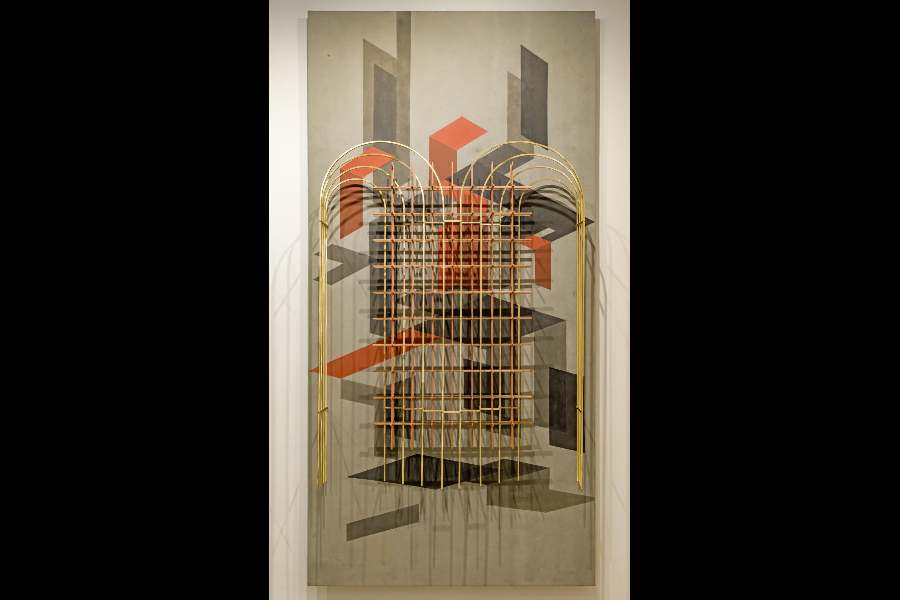Borders can divide land on a map but in the minds of immigrants, spaces divided by geography can coalesce in curious ways, forming new places that refuse to be bound by the restrictive structures of reality. Such spaces can be unsettling for those who have not experienced the alienation of an immigrant’s life as they defy expected patterns and are shaped by a curious mix of things that one perhaps would not expect to find together. It is thus fitting that a recent exhibition of the works of the late Kanishka Raja and Rathin Barman at Experimenter, Ballygunge Place was titled (Un)Settled. Born in Calcutta, into a family whose design aesthetics — Raja’s father was a textile designer — left a deep imprint on his mind, Raja moved to the United States of America to study and teach and, later, settled there. Rathin Barman, on the other hand, migrated to North Calcutta from his village in Tripura a few decades ago. The artistic idioms of both artists are thus shaped by the experience of inhabiting liminal spaces between the lands of their birth and those they later inhabited.

Rathin Barman Unsettled Structure XVII, 2024 Brass, copper plated mild steel, graphite, charcoal and paint on concrete board 96 x 48 x 10 in 243.8 x 121.9 x 25.4 cm
To the uninitiated viewer taking in the exhibition for the first time, it might seem like the two artists and their art have nothing in common. In fact, even those familiar with Raja’s oeuvre might ponder why it is his American Paintings series that was shown alongside Barman’s work when the geometric abstraction of his Control series — exhibited in 2022 at Experimenter’s show, Ground Control — would have melded seamlessly with Barman’s meticulously architectural body of work. Yet, it is this rejection of a familiar pattern that encapsulates the immigrant experience. Raja’s paintings are figurative whereas Barman’s pieces are abstract. But both imagine lived spaces — the home — as ambiguous, amorphous zones that shapeshift not just based on the perspectives of their inhabitants, their memories and their interpersonal ties but also on the basis of changing historical narratives, socio-economic conditions and so on. Barman’s works, for instance, capture the stories of the current inhabitants of the old houses as well as those of rich traders from the era of the raj who built these now-crumbling edifices. Even though human experiences shape these spaces, the works of both Barman and Raja are completely devoid of the human presence, leaving the viewer alone to contemplate the haunting echoes in these rooms.
Where their approaches differ perhaps is in the exteriority of the viewer to Raja’s works versus their interiority in Barman’s. Raja’s oil on canvases are of rooms where the viewer stands at the threshold, looking in as the artist conjures a strange combination of indoors and outdoors with screens and wallpapers where cultural and architectural features from India and the US intersect. Highway Star (picture, left) is a good example of such a cultural cross-match: a spartan room lined with pink wallpaper has a moshari on a four-poster bed that would be instantly recognisable to any Calcuttan; yet on the wall — is that a poster or a window? — is a blue Ford Mustang, a car once ubiquitous in America. Strewn throughout his other paintings of rooms are signs of kitschy American life as well as of middle-class Calcutta. Raja also painted other transitory spaces like airports, which perhaps capture a world of in-betweenness better than any other place.
Barman’s brass, copper and concrete scaffolding-like structures (picture, right) invite viewers to step in, walk through, and explore. The huge Unsettled Structure I, placed under the gallery’s massive skylight, is fascinating in the shadows that it casts and the perspectives that it offers to a viewer walking through it. In the Spatial Notations series, Barman turns concrete tiles into his canvas. On these, Barman maps out three-dimensional floor plans where light, depth and human emotions — a favourite corner of the house perhaps or even a room with scary memories — are depicted in Mondrian-esque patches of colour.
In the end, Raja and Barman question how unsettling it can be to settle for people who live forever in between two worlds.
